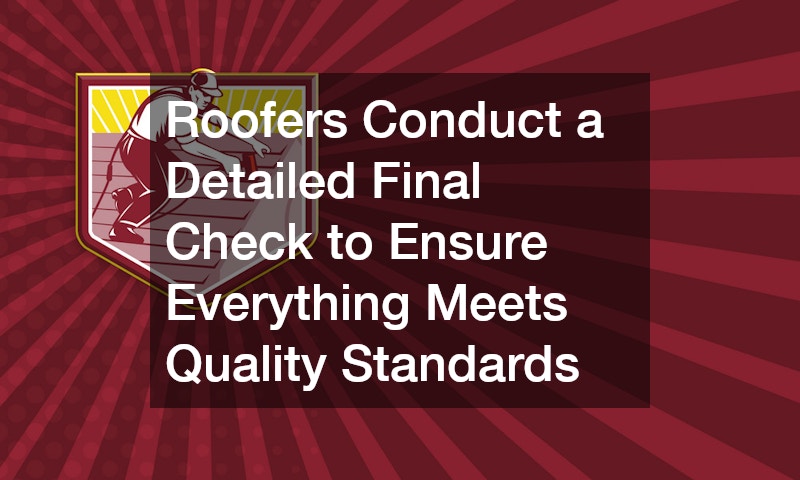The process of roof replacement begins with a comprehensive inspection and assessment. Roofers examine the current state of the roof to determine the extent of damage or wear. This evaluation allows them to establish whether a full replacement is necessary or if repairs can suffice in certain areas. Inspection includes checking for leaks, broken shingles, and structural issues.
Roofers utilize their expertise to assess what materials and tools will be required for the replacement job.
After the initial inspection, roofers will provide the homeowner with an estimated cost and timeline. This stage is crucial for setting realistic expectations regarding the project’s duration and financial implications. This estimate is often based on the size of the roof, the materials selected, and the complexity of the job. Discussing all these details transparently helps in preventing any misunderstandings later in the process. Additionally, roofers will work with homeowners to select roofing materials that suit both needs and budget.
Obtaining the necessary permits is another vital step before beginning any roofing work. Roofers are responsible for ensuring that all the legal requirements are met and that the project adheres to local building codes. Having the correct permits not only ensures legality but also safety throughout the project. Neighbors will be informed about the timeline of the project to minimize disruptions. Once all necessary preparations are in order, roofers schedule the start date for the roof replacement.
Removing the Old Roof
Removal of the existing roof is the next step in the replacement process. Roofers carefully remove old shingles, nails, and underlayment to prepare for the new materials. Roofers also take care to protect the property from falling debris during this phase. Depending on the condition of the old roof, this process might be challenging, requiring significant labor and time investment. This step allows the roofers to inspect the underlying structure more thoroughly and address any hidden issues.
Discarding the old roofing materials follows strict protocols to ensure environmental responsibility. Roofers often recycle materials like asphalt shingles, metal, and wood to minimize waste. Waste management is an integral part of professional roofing services, reflecting their commitment to sustainability. Furthermore, roofers ensure that the removed materials do not pose a hazard to the surrounding area. Efficient cleanup efforts are vital to maintain safety and cleanliness around the workspace.
Once the old roof is removed, roofers conduct a secondary inspection of the roof deck to ensure its integrity. Any rotten wood or structural problems are addressed immediately to ensure the longevity of the new roof. This step is crucial to prevent future issues, such as leaks or sagging, which could compromise the roof’s performance. Structural adjustments or repairs are made at this stage to provide a solid base for the new roof. With the roof deck prepared and secure, the roofers can move forward with the installation of new materials.
Installing the New Roof
Installation begins with laying a water and ice shield as well as an underlayment to provide additional protection against moisture. This prevents future water damage, ensuring the roof’s durability. Roofers carefully select these materials to match the specific needs of the location, taking into account the local climate and environmental conditions. The underlayment is an essential barrier that acts as the final protection against leaks. Once in place, roofers are ready to install the roofing material itself.
The next step involves the meticulous installation of new shingles, tiles, or metal panels, depending on the selected material. Roofers work systematically, ensuring each piece is aligned properly and securely fastened. The precision of this process affects the roof’s overall appearance and functionality. Roofers use their skills to ensure that the roof not only looks appealing but also performs effectively against weather conditions. Timely and precise installation is key to avoiding future issues like shingles lifting or water infiltration.
Roofers finalize the installation by adding finishing touches, such as ridge caps and ventilation systems. This step is crucial for regulating attic temperature and prolonging the life of the roof. Proper ventilation helps in reducing energy costs by maintaining an ideal temperature, reducing strain on heating and cooling systems. Lighting and gutter systems are adjusted or installed to complement the new roofing structure. By completing these steps, roofers ensure complete satisfaction with the new roof, providing peace of mind and safety to the homeowner.
Final Checks and Cleanup
Once the installation is complete, roofers conduct a detailed final check to ensure everything meets quality standards. This involves looking for any imperfections or missed spots, verifying the structural integrity and appearance. This inspection confirms that the roof is safe, secure, and built to last. It is the roofer’s responsibility to validate the effectiveness of their work and provide assurance to the homeowner. By conducting thorough checks, roofers reinforce their commitment to quality craftsmanship.
Following the final checks, roofers initiate a comprehensive cleanup process around the property. Removing leftover materials and debris safeguards the surrounding environment and ensures a neat finish. Cleanup operations extend to correcting any disturbances that occurred in the landscaping or home structure due to roofing activities. Roofers aim to leave the property better than they found it, highlighting their professional ethos. Responsibly disposing of or recycling waste material also reflects a commitment to environmental stewardship.
After successful completion of all steps, roofers review the warranty with the homeowner. Explaining the coverage and lifespan of the new roof is crucial for peace of mind. Additionally, roofers provide maintenance tips to maximize the roof’s longevity and to prevent future issues. All documentation and relevant details about the installation are handed over for records. With everything finalized, roofers complete their task, having provided a reliable and expertly crafted roof.




